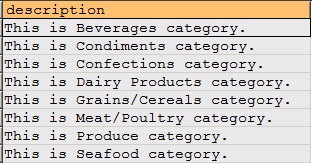


#Mysql concat string with column value code
If you add a NULL value, the CONCAT function returns a NULL value as follows: SELECT CONCAT( 'MySQL', NULL, 'CONCAT') Code language: SQL (Structured Query Language) ( sql ) SELECT CONCAT( 'MySQL', 'CONCAT') Code language: SQL (Structured Query Language) ( sql ) The following statement concatenates two quoted strings: MySQL and CONCAT. If any argument is NULL, the CONCAT function returns a NULL value. The CONCAT function converts all arguments to the string type before concatenating. ) Code language: SQL (Structured Query Language) ( sql ) The following illustrates the syntax of the CONCAT function. The CONCAT function requires a minimum of one parameter otherwise it raises an error. The MySQL CONCAT function takes one or more string arguments and concatenates them into a single string. In Microsoft SQL server, you use the addition arithmetic operator (+) to concatenate string values.īesides using spaces for string concatenation, MySQL provides two other functions that concatenate string values: CONCAT and CONCAT_WS. For example, if you use PostgreSQL or Oracle, you have to use the string concatenation operator ||. MySQL string concatenation is cleaner in comparison with other database management systems. To concatenate two or more quoted string values, you place the string next to each other as the following syntax: SELECT 'MySQL ' 'String ' 'Concatenation' Code language: SQL (Structured Query Language) ( sql ) Not a MySQL guy but this code should be fairly close to what you need.Summary: in this tutorial, you will learn various ways to concatenate two or more strings together by using the MySQL CONCAT and CONCAT_WS functions. (select id, duration from course order by duration asc) yīasically, I placed your query inside a subquery and applied the generic expression. But How would I work this around my code as so select id, duration, := + 1 as position from (select := 0) x, (select id, duration from course order by duration asc) y SELECT id,CONCAT(position,IF(MOD(position,100) IN (11,12,13),'th', Hey Rolando, I understand roughly how you have implemented this. UNION SELECT 5 UNION SELECT 6 UNION SELECT 7 UNION SELECT 8 UNION SELECT 9) U) A (SELECT 0 u UNION SELECT 1 UNION SELECT 2 UNION SELECT 3 UNION SELECT 4 UNION SELECT 5 UNION SELECT 6 UNION SELECT 7 UNION SELECT 8 UNION SELECT 9) T, (SELECT 0 t UNION SELECT 1 UNION SELECT 2 UNION SELECT 3 UNION SELECT 4 UNION SELECT 5 UNION SELECT 6 UNION SELECT 7 UNION SELECT 8 UNION SELECT 9) H, (SELECT 0 h UNION SELECT 1 UNION SELECT 2 UNION SELECT 3 UNION SELECT 4 UNION SELECT 5 UNION SELECT 6 UNION SELECT 7 UNION SELECT 8 UNION SELECT 9) TH, (SELECT 0 th UNION SELECT 1 UNION SELECT 2 UNION SELECT 3 UNION SELECT 4 To test this out, run the following SELECT CONCAT(num,IF(MOD(num,100) IN (11,12,13),'th', All other two-digit combinations have th appended.If the last digit of a number is 3 (other than last two digits being 13), rd is appended.If the last digit of a number is 2 (other than last two digits being 12), nd is appended.If the last digit of a number is 1 (other than last two digits being 11), st is appended.I have the generic expression you need: SELECT IN IN this does is the following


 0 kommentar(er)
0 kommentar(er)
